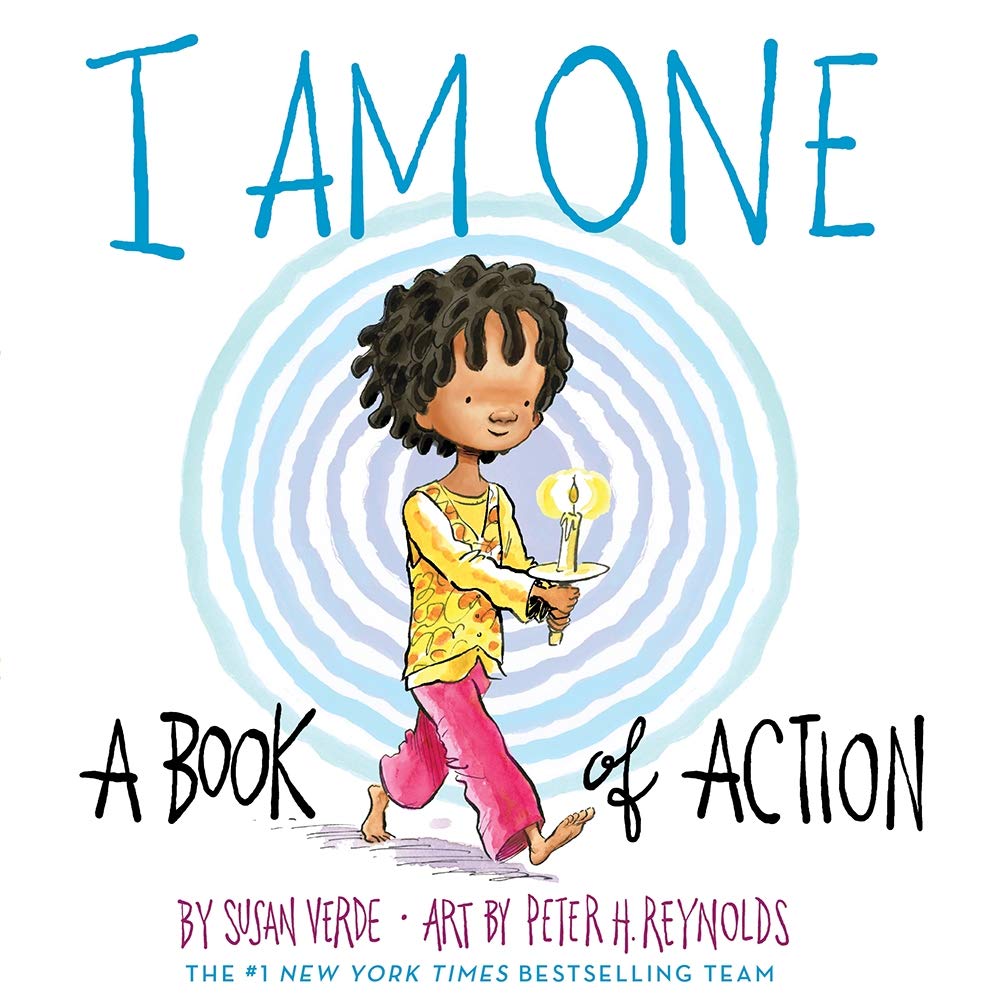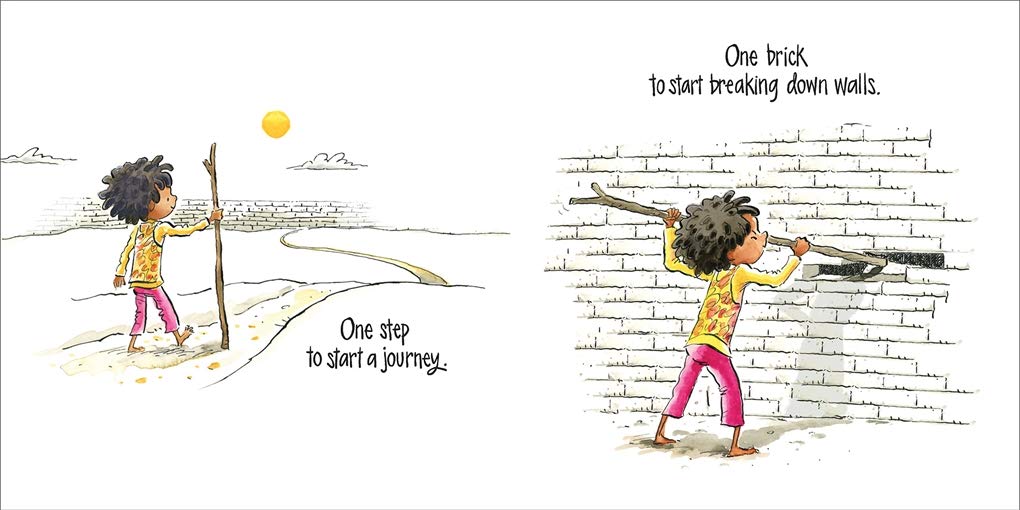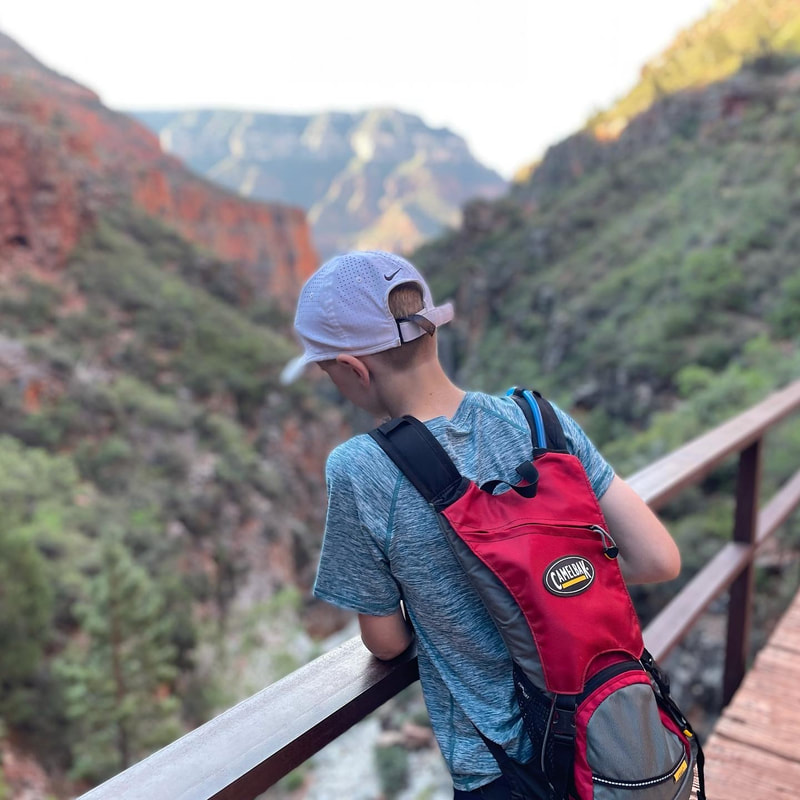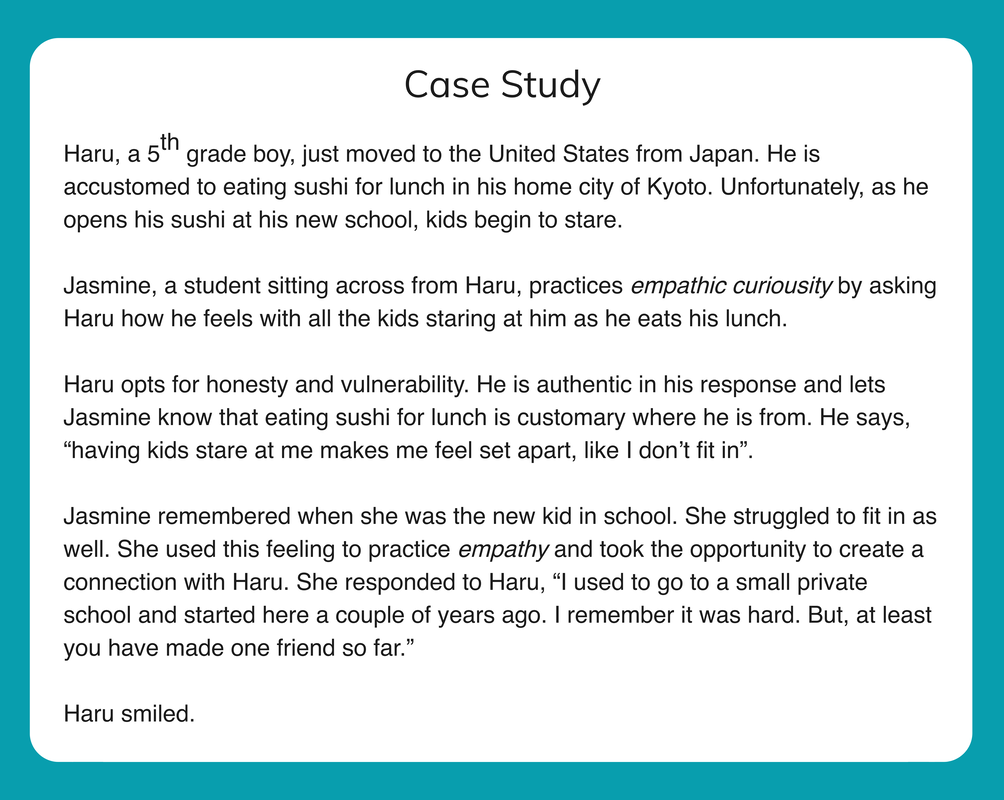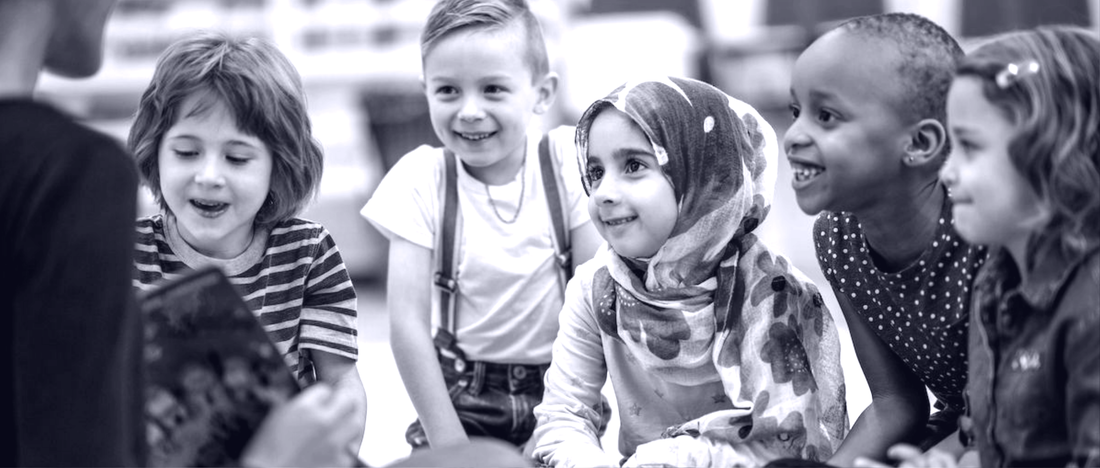The power ONE person has to impact another with ONE word. The healing power of ONE touch. The ripple effect of ONE action. The joy or strength in ONE connection. Verde removes the overwhelming complexity to bring about change by repeatedly drawing her readers’ attention to the power of ONE. The author ends the book with an empowering message: One person's small start is enough to trigger a collective action. I am one. And I can take action. We are each one. And we can take action. A Vibrant Journey To Collective ActionPeter Reynolds is an author and illustrator who brings I Am One: A Book of Action to life with soft lines and vibrant colors. With each page, he escorts the viewer deeper into a relationship with the main character. Reynolds' illustrations depict the journey of one child taking repeated actions to culminate in a collective movement. This visual representation of the story deepens the textual message. While the author does not draw the reader's attention to a main character, the illustrator does. The juxtaposition of Verde's feasible approach to action with the evolution of Reynolds' more complex illustrations impact the reader in two ways:
There is no doubt the illustrations and the text in this book could stand on their own; however, the potential impact they have together is more than either could have achieved solitarily. The collaborative effort of the book itself is a tangible example of the story’s main idea. ONE idea, ONE word, and ONE stroke have developed into ONE book. While the author and illustrator may humbly question the impact this book has or will have to create a movement. I would argue, it has and it will. I Am One: A Book Of Action simplifies a complex and substantial message for young readers. The harmony of Verdes' words and Reynolds' illustrations engage young readers and inspire them to believe they too can be ONE of action.
0 Comments
The Need for Belonging and How We Help It Flourish in Our Schools
Belonging at school is a critical component of student success, academically, socially, and emotionally. However, across the globe, students have been reporting experiencing lower rates of belonging in recent years. Upon reading this, the questions for educators are as follows: How exactly does a student’s sense of belonging impact their life in and out of school? How do I know if my students feel like they belong at school? What can we do to foster a sense of belonging in all of our students? Let’s address those questions now.
A Brief History of Empathy
Empathy is a rather new discovery and has evolved since its first introduction to the United States in the early 1900’s. The word empathy means “in-feeling”. The Greek “em” means “in” and the Greek “pathos” means “feeling.”
Upon its origination, it was characterized as a person’s ability to project their feelings into the world. In a Psychology Today article, Dr. Susan Lanzoni Ph.D., shares a couple of examples of this:
Like any newfound knowledge; time, technology, and curiosity, lead to improved understanding and additional discoveries. As we neared the mid-1900’s psychologists began to consider a person’s empathy for others; the ability to put themselves in others' shoes. Then, in the late 1900’s neuroscientists discovered mirror neurons. This added a new layer of interest and understanding about empathy. Today, empathy, like curiosity, is riddled with complexity. Social Psychologist C.Daniel Batson, an empathy researcher, explores eight different facets of empathy. His work, while interesting, is far too complex when it comes to our focus on school communities. Why is this brief history of empathy important for school leaders?
Empathic Curiosity
Last week we shared an article, “Help Me Discover Who I Am", about the connection between learner identity development and curiosity. One of the three types of curiosity shared in this article is called empathic curiosity. Empathic curiosity motivates understanding about the thoughts and feelings of other people.
This is where empathy and curiosity collide. Understanding and practicing empathic curiosity can help your learners be known. It is through this interest and questioning of one another’s thoughts and feelings that opportunities for authenticity and connection are created. However, empathic curiosity will not lead to authenticity and connection without empathy.
The above case is fictitious and uncommon in most school communities. In fact, it is uncommon in life. But, this is where Cultured Kids is making an impact. Within the provided case are the following steps:
However uncommon the outcomes, this scenario is widespread in American schools, especially in diverse metropolitan areas. It is not beholden to food, but is expressed through differences in clothing, areas of interest, customs celebrated, hair products used, languages spoken, and physical characteristics. If any one of the following steps was not executed the opportunity for connection would be lost, trust not established, and the sense of belonging diminished. While it was Jasmine’s empathic curiosity that created the opportunity for connection, it was her practice of empathy that created the connection. Additionally, her ability to practice empathy required Haru’s vulnerability. Empathy As A Bridge To Belonging
If vulnerability is present, empathy will be the bridge needed to establish trust. You can easily replace vulnerability with authenticity here. When your learners are confident and understand who they are, they can choose whether or not to share who they are with others. Choosing authenticity means risking physical or emotional harm (vulnerability).
The more your students choose authenticity and practice responding to authenticity with empathy, the more trust will prevail. From this place of trust an increased sense of belonging and greater school unity will follow. Global Citizenship
Now, take a moment to transition from your internal perspective (your school community), to an external perspective (the world). Empathy...
Your ability to adopt and practice empathy as a school community will not only foster school unity, but will lay the foundation for your learners to succeed as effective global citizens. Let's Build Bridges
Apathy is a lack of feeling; to not care. Apathy is the opposite of empathy. Ineffective global citizens will be apathetic. How will they cross the chasm? We need to build bridges of empathy.
While giving a speech at Northwestern In 2006, Barack Obama said, “As you go on in life, cultivating this quality of empathy will become harder, not easier. There’s no community service requirement in the real world; no one forcing you to care.” Understanding that empathy development will become more challenging for learners as they age means that apathy will become easier. Cultured Kids does not exist to merely help kids understand and practice empathy, but to own it! We want empathy to be a part of each child’s way of life. We want children to lead with empathy and to be shielded from apathy. Cultured Kids sees school communities as a microcosm of the world. This microcosm is not merely an institution to support children's' education, it is a potential model for what is possible to achieve in the world. By partnering with leaders who prioritize empathy, we are ensuring the next generation of world leaders have a chance at effective global citizenship.
Who Am I?
These three simple words live in the minds of many children in your school community. This question peaks at the convergence of identity and curiosity, and results in a complexity not easily understood by them.
It is our hope that all learners will be able to ask and answer this question. We believe their sense of belonging depends on it. However, there is a danger to this question as well. If your students are not provided a safe environment to discover who they are, they will be susceptible to believing who others say they are. I liken a child’s identity to a mound of soft clay. The form the clay takes will depend on the artist shaping it. What influencers are molding your students’ identities? Are your students making their own contributions? Cultured Kids is on a mission to unify school communities. Positive identity development and healthy self-discovery are key ingredients to our desired outcome. In order for a child to be truly known by their peers, they need to know themselves. Different Types of Curiosity
In Ian Leslie’s book, Curious, he shares three types of curiosity:
Let’s consider anthropologist Jane Goodall as an example to showcase each of these types of curiosity. When Jane was a child she was given a stuffed chimpanzee by her father. This gift sparked diversive curiosity, which motivated an interest in, and exploration of, animals. As she grew up her level of interest evolved. It was Jane’s epistemic curiosity (and some financial support) that led her to work on a farm in Kenya and earn a PhD in Ethology. Finally, Jane’s extensive research living among chimpanzees was the result of her empathic curiosity. Diversive Curiosity
Hopefully we all give into diversive curiosity throughout our lives. Learning new skills, exploring new lands, and meeting new people help us to become more adaptable, likeable, and healthy.
It is easy to see this type of curiosity in your lower elementary learners. Children enroll at school with a sense of awe and wonder about the world. We are all familiar with the “Why?” stage children go through. In these early stages, Cultured Kids aims to nourish and grow diversive curiosity. Through compare and contrast, learners can explore differences and similarities between themselves and peer groups globally. Activities that support exploration and discovery help to solidify some aspects of their individual identities. Additionally, children are also gaining foundational building blocks for constructive discussions about culture, race, and ethnicity. By consistently encouraging diversive curiosity, learners will identify areas of deeper interest. Interests that will motivate a disciplined effort towards deeper understanding as they grow older. Epistemic Curiosity
In order to unify your school communities, each community member needs to feel a healthy sense of belonging. We define a healthy sense of belonging as a child’s ability to know and safely share their authentic self with others.
Knowing their authentic selves requires epistemic curiosity and safely sharing it requires empathic curiosity. We encourage and support these types of curiosity with upper elementary and middle grade students. Greater self-esteem, self-confidence, and student voice come with a secure understanding of who they are. But, supporting this deeper process of self-discovery has other benefits as well:
Like Jane Goodall, many of your students will trace their future passion back to a specific event or experience as a child. Alternatively, some will find comfort in diversive curiosity and change professions, locations, or partners regularly, craving new places, experiences, and people. Through it all, one person will remain consistently present: themselves! However, just like our professions, life partners, and locations are not fixed, neither are some aspects of our identity. Our life experiences will consistently challenge us to evaluate who we are. Self-curiosity and positive identity development will support unity in your schools. But, they will also prepare learners for life. Empathic Curiosity
Quite often, we make assumptions about others. We can do this with our colleagues, staff, and students. Educators and students will do this as well. It is part of the human condition.
When we make assumptions, we trade questioning for knowing. For example, I can assume Brenda is not facilitating morning meetings on a regular basis with her class because she has poor time management. Believing I know this, stifles my curiosity. Alternatively, if I rely on my empathic curiosity and begin asking questions about Brenda and her class, I would come to some sharp realizations. Brenda’s students all rely on the school breakfast for a healthy meal. In addition, a large group of Brenda’s kids are the last group to get dropped off in the morning. Brenda knows hunger will stand in the way of her students learning. So, she prioritizes their nourishment over morning meetings. What does empathic curiosity have to do with your students' identity development? There are two reasons why this type of curiosity is important:
Does Curiosity Precede Your Desired Achievement?
Ken Robinson said, “Curiosity is the engine of achievement”. If this is true, then school leaders should be prioritizing question development. Questions foster deeper curiosity.
A Right Question Institute study, based on question-asking data gathered by the National Center for Education Statistics, shows a steady decline in question asking throughout a learners K-12 journey. An average of 100 or more questions a day is depleted to a handful by the time children graduate from high school. There are many reasons why this shift occurs. In Warren Berger’s, The Book of Beautiful Questions, he lists five enemies of questioning: fear, knowledge, bias, hubris, and time. Your educators, students, and parents may embody one or more of these enemies of questioning at any moment. We believe “Curiosity is the engine of achievement” because achievement can take many forms. No matter what form you want it to take, the statement still serves true. When considering your students and their journey of self-discovery, we believe curiosity is the engine of self-exploration, self-understanding, and self-acceptance.
Rise Of The AmphibiansI was delightfully surprised and slightly disheartened by a New York Times op-ed piece, The Rise of The Amphibians, by David Brooks.
Delightfully surprised because his article filled a great need: increased awareness of the challenges faced by children who are raised cross-culturally. His piece also presented some clear ways this growing population will contribute to global advancements and help close cultural gaps surrounding us. I was slightly disheartened because only one paragraph (quoted below) glossed over the challenges that these children will face throughout their lives: Vertical Divider
Defining Professional DevelopmentThe development of any individual, group, or project implies growth, progress, or an advancement from its original form. If you were to look up the definition for professional you would see its most common correlation to that of an occupation.
It goes without saying then, that professional development provides an opportunity for growth or progress in your given occupation. Unfortunately, I think we are overlooking one very significant aspect within our definition of professional. Is the connection to a specific occupation enough to gain development in that area? Just as we consider the obstacles that hinder student learning in the classroom, we should also consider what is standing in the way of educators’ learning. Providing professional development does not automatically yield individual or communal development. Educators must be willing, ready, and eager to be developed. It is for this reason that I prefer to see professional development as an outcome rather than a process. I have defined professional development as: the professional advancement possible when the content, delivery, and participant engagement are aligned. |
�
Categories
All
Archives
September 2023
|
Follow Us
© Cultured Kids Inc.

